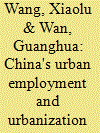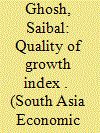| Srl | Item |
| 1 |
ID:
130972


|
|
|
|
|
| Publication |
2014.
|
| Summary/Abstract |
The present paper argues that China's existing population and employment statistics are misleading, and have failed to include many of the migrant and labor force flows between urban and rural areas. The paper reconciles the differences between official census data and other survey statistics and attempts to recalculate China's urban population and employment figures. Our analyses indicate that official statistics of 2012 underestimate China's urban employment by approximately 47 million while overestimating rural employment by 31 million. The adjusted urbanization rate exceeded 55 percent in 2012, almost 3 percentage points higher than the official statistics. Nevertheless, there remains much potential for rural-to-urban migration. More specifically, if the current bottlenecks in household registration, social security and public welfare systems can be removed or relaxed, China's urbanization rate could rise by another 10 percentage points or even more over the next decade.
|
|
|
|
|
|
|
|
|
|
|
|
|
|
|
|
| 2 |
ID:
143532


|
|
|
|
|
| Summary/Abstract |
Employing decadal data for the period 1971–2011, this article constructs a quality of growth index (QGI) for major Indian states. The index encompasses not only growth and its durability, but also encompasses several relevant social dimensions. These include variables such as stability and diversification of growth as well as institutional quality and social indicators such as life expectancy and literacy rate. The extended period chosen enables us to trace the evolution of the index over a sufficiently long period of time. Several findings stand out. First, the average value of the index is higher in the post-reform period, suggesting that there has been an overall improvement in the quality of growth over time. However, although the BIMAROU states have raised their QGI, they have still lagged behind their peers. Second, it is typically the industrialized states which have witnessed higher QGI. And third, the industrialized states, with improved financial access and better physical infrastructure, which are better placed are those with higher QGI.
|
|
|
|
|
|
|
|
|
|
|
|
|
|
|
|